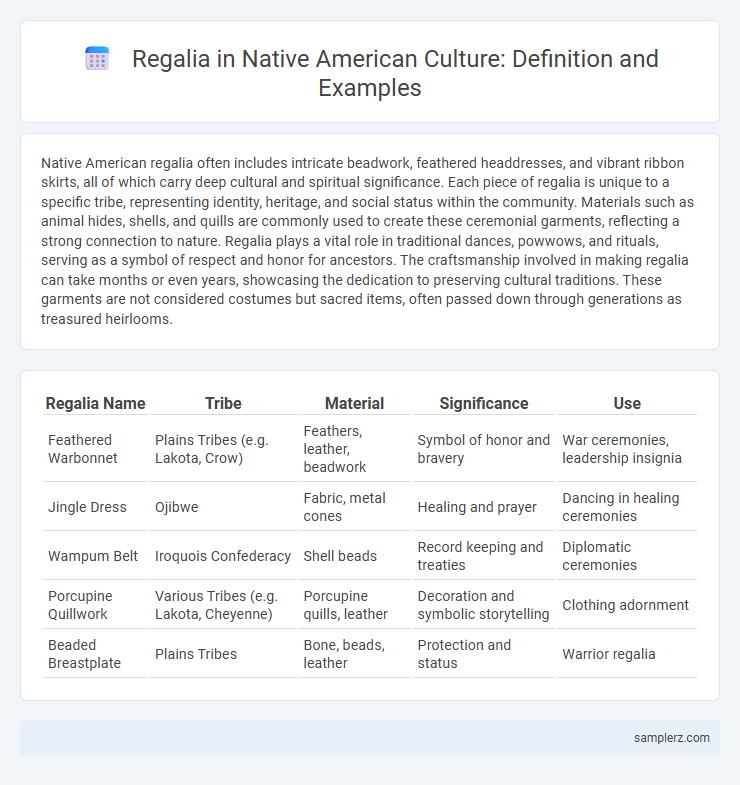Native American regalia often includes intricate beadwork, feathered headdresses, and vibrant ribbon skirts, all of which carry deep cultural and spiritual significance. Each piece of regalia is unique to a specific tribe, representing identity, heritage, and social status within the community. Materials such as animal hides, shells, and quills are commonly used to create these ceremonial garments, reflecting a strong connection to nature. Regalia plays a vital role in traditional dances, powwows, and rituals, serving as a symbol of respect and honor for ancestors. The craftsmanship involved in making regalia can take months or even years, showcasing the dedication to preserving cultural traditions. These garments are not considered costumes but sacred items, often passed down through generations as treasured heirlooms.
Table of Comparison
| Regalia Name | Tribe | Material | Significance | Use |
|---|---|---|---|---|
| Feathered Warbonnet | Plains Tribes (e.g. Lakota, Crow) | Feathers, leather, beadwork | Symbol of honor and bravery | War ceremonies, leadership insignia |
| Jingle Dress | Ojibwe | Fabric, metal cones | Healing and prayer | Dancing in healing ceremonies |
| Wampum Belt | Iroquois Confederacy | Shell beads | Record keeping and treaties | Diplomatic ceremonies |
| Porcupine Quillwork | Various Tribes (e.g. Lakota, Cheyenne) | Porcupine quills, leather | Decoration and symbolic storytelling | Clothing adornment |
| Beaded Breastplate | Plains Tribes | Bone, beads, leather | Protection and status | Warrior regalia |
Introduction to Native American Regalia
Native American regalia encompasses traditional clothing, jewelry, and accessories that reflect tribal identity, history, and spirituality. Common elements include intricately beaded moccasins, feathered headdresses, and elaborately decorated dresses or shirts, each symbolizing cultural heritage and social status. These regalia pieces are often worn during ceremonies, powwows, and dances, serving as vibrant expressions of tribal pride and ancestral lineage.
Historical Significance of Regalia
Native American regalia holds profound historical significance as it embodies tribal identity, spiritual beliefs, and social status passed down through generations. Each element, such as feathered headdresses, beadwork, and fringed garments, carries symbolic meanings tied to warrior achievements, ancestral heritage, and ceremonial roles. These regalia pieces serve as living connections to Native American history, preserving cultural narratives and honoring traditions during powwows and sacred rituals.
Common Materials Used in Regalia
Common materials used in Native American regalia include feathers, beads, leather, and porcupine quills, each holding cultural significance and symbolizing tribal identity. Traditional regalia often incorporate animal hides, bones, and shells, reflecting the wearer's connection to nature and ancestral heritage. These materials are meticulously crafted to honor spiritual beliefs and preserve cultural traditions during ceremonies and dances.
Feather Headdresses: Symbolism and Meaning
Native American feather headdresses, often called war bonnets, symbolize honor, bravery, and spiritual connection, traditionally worn by respected leaders and warriors. Each feather represents a significant act of courage or achievement, making the headdress a powerful emblem of personal and tribal identity. The intricate designs and sacred feathers, typically from eagles, embody deep cultural values and a spiritual link to the natural world.
Beadwork in Native American Regalia
Beadwork in Native American regalia is a vibrant form of artistic expression that symbolizes cultural heritage, identity, and spiritual beliefs. Intricate patterns made using glass seed beads are sewn onto clothing, moccasins, and accessories, often reflecting tribal stories and individual achievements. This beadwork is crafted with deep respect for tradition, often passed down through generations to preserve the cultural legacy.
Powwow Dance Outfits and Their Importance
Powwow dance outfits in Native American culture serve as vibrant regalia that embody tribal identity, spiritual beliefs, and ancestral heritage through intricate beadwork, feathers, and symbolic colors. These outfits play a crucial role in ceremonies and social gatherings, enhancing the dancer's connection to their community and the natural world. The craftsmanship and unique designs of each regalia showcase the diversity and continuity of Native American cultural traditions.
Traditional Jewelry and Accessories
Native American regalia prominently features traditional jewelry such as turquoise and silver necklaces, beaded chokers, and intricate shell and bone earrings, symbolizing cultural identity and spiritual significance. Feathered headdresses and elaborately beaded belts and armbands serve as important ceremonial accessories, reflecting tribal heritage and social status. These items are often handcrafted using age-old techniques passed down through generations, showcasing a rich history of craftsmanship and symbolism.
Regional Variations of Regalia Styles
Native American regalia exhibits distinct regional variations reflecting diverse cultural identities, with Plains tribes favoring feathered war bonnets symbolizing bravery, while Southwestern tribes incorporate intricate beadwork and turquoise in their attire, representing spiritual protection. In the Pacific Northwest, regalia often features carved wooden elements and vibrant Chilkat blankets, emphasizing clan stories and lineage. These stylistic differences not only highlight the environmental influences but also the unique historical and spiritual traditions embedded within each tribe's ceremonial dress.
Contemporary Adaptations of Regalia
Contemporary adaptations of Native American regalia integrate traditional materials and symbols with modern fabrics and design techniques, reflecting evolving cultural identities. Beadwork, feathers, and textiles are often combined with contemporary elements like denim or synthetic fibers, maintaining symbolic significance while appealing to younger generations. These adaptations foster cultural expression and continuity, showcasing innovation within Native communities while honoring ancestral heritage.
Preservation of Regalia Traditions Today
Native American regalia, such as intricate beadwork, feathered headdresses, and woven textiles, symbolize deep cultural heritage and spiritual significance, with communities actively preserving these traditions through dedicated craft workshops and intergenerational teaching. Tribes like the Lakota, Navajo, and Cherokee use digital archives and museum collaborations to safeguard regalia knowledge and ensure authenticity in contemporary creation. The ongoing cultural revival movements emphasize respect for traditional materials and techniques, sustaining the vibrant legacy of Native American regalia in modern ceremonies and powwows.

example of regalia in Native American Infographic
 samplerz.com
samplerz.com